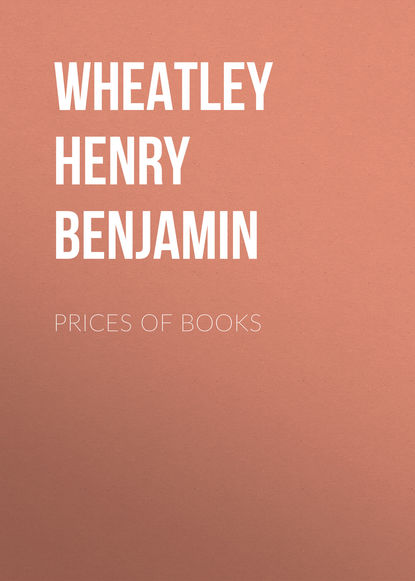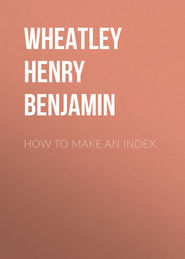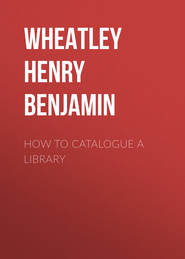По всем вопросам обращайтесь на: info@litportal.ru
(©) 2003-2024.
✖
Prices of Books
Автор
Год написания книги
2018
Настройки чтения
Размер шрифта
Высота строк
Поля
Pericles (H. Gosson), 1609.
Steevens, £1, 2s. Roxburghe, £1, 15s.
Heber, Part 2, £18—bought by Daniel; sold at his sale for £84.
F. Perkins, 1889 (Steevens’s copy, with his autograph), £60. Halliwell Phillipps (1889), £30 (title reprinted, and two leaves wanting).
J. T. Frere, 1896, £171.
Richard II. (Valentine Simmes for Andrew Wise), 1597.
Daniel’s was the first copy brought to auction. Bought by Lilly (1864) for 325 guineas.
–– (Val. Simmes for Andrew Wise), 1598.
Steevens, £4, 14s. 6d. Roxburghe, £7, 7s. White Knights, £10. Heber, £4, 14s. 6d. Bright 1845), £13, 10s. Daniel (1864), 103 guineas—Halliwell.
Richard III. (Valentine Sims for Andrew Wise), 1597.
Nixon (1818), £33; resold to Heber. Heber (Part 2), £41, 9s. 6d.; bought by Daniel; sold at his sale for 335 guineas to Lilly.
Romeo and Juliet (John Danter), 1597.
Heber, Part 2 (wanting title, and cut into the text), £1, 1s.
Kemble gave Stace the bookseller £30 for his copy, now in the library of the Duke of Devonshire.
Romeo and Juliet, second or first complete edition (T. Crede for C. Burby), 1599.
Steevens, £6. Roxburghe, £7, 10s. White Knights, £10, 10s. Heber, £5, 15s. 6d. Daniel, £52, 10s. F. Perkins (1889), £164 (headlines cut into, and title mounted).
Taming of the Shrew, Tempest, Timon of Athens, first editions in folio.
Titus Andronicus (Edward White), 1611.
Daniel (1864), £31, 10s.
F. Perkins (1889), £35 (margin of title repaired).
Troilus and Cressida (G. Eld for R. Bonian & H. Walley), 1609.
Boswell, 13s. Steevens, £5, 10s. Roxburghe, £5, 5s. Heber (Part 2), £16. Daniel (1864), 109 guineas; this fine copy, with second title, cost him £50. F. Perkins (1889), £30 (headlines cut off).
Two Gentlemen of Verona, Winter’s Tale, first editions in folio.
Venus and Adonis (Richard Field), 1593.
Malone gave £25 for his unique copy, now in the Bodleian.
–– (Richard Field), 1594.
Jolley (1844), £106 (close cut, and mended); now in the Grenville Library. Daniel (1864), £240—Lilly; finest copy known.
Venus and Adonis (R. F. for John Harrison), 1596.
Sir W. Bolland (1840), £91—Bright; Bright’s sale (1845), £91, 10s.—Daniel; Daniel’s sale (1864), 300 guineas—Boone.
Lucrece (Richard Field for John Harrison), 1594.
Baron Bolland (1840), £105. Bright, £58 (top margin repaired). Daniel (1864), 150 guineas—Lilly. W. H. Crawford (1891), £250. Mr. Holford is said to have given £100 for his copy. F. Perkins (1899), £200 (small hole burnt in two leaves).
Sonnets (G. Eld for T. T.), 1600.
Steevens, £3, 19s.; this copy cost Narcissus Luttrell 1s.; at Daniel’s sale (1864) it realised 215 guineas. Edwards (1804), £8. Longman’s Catalogue, £30. Roxburghe, £21. Chalmers (1841), £105. Halliwell (1856), £41—bought by Mr. Tite. Halliwell (1858), £154, 7s.—bought by Mr. Huth.
Poems (Thomas Cotes), 1640.
Collins (1683), 6d. Lloyd & Raymond (1685), 6d. Field, £2, 5s. Nassau, £3, 13s. 6d. Bindley, £5, 15s. Longman’s Catalogue, £8, 18s. 6d.; another copy, £10, 10s. Stowe, £7, 10s. Bright, £15. Daniel (1864), £44. F. W. Cosens (1890), £61.
CHAPTER XI
PRICES OF VARIOUS CLASSES OF BOOKS
In this chapter some account will be given of a few of the various classes of literature which have not previously been alluded to; but to give a general idea of some of these books which bring a high price, it will be necessary to be brief.
Oldys refers to the sale of a book which he supposes to have been erroneously valued, but he was not quite correct in his statement. He wrote, “The atheistical book of Giordano Bruno sold at Paul’s Coffee-house for £30 in 1709; it has scarcely sold for so many pence since.”[56 - “Memoir of William Oldys,” 1862, p. 104.]
The book referred to was—Giordano Bruno, Spaccio de la Bestia Trionfante. Parigi (Londra: T. Vautrollier 1584), the sale of which is commented upon in The Spectator, No. 389. The sale at which this book occurred was that of Charles Bernard in 1711, and the amount was really £28. The purchaser was Walter Clavel, and this copy was successively in the possession of John Nichols, John Ames, Sir Peter Thompson, and M. C. Tutet. At the sale of the latter’s library in 1786 it was bought by Samuel Tyssen for seven guineas. Another copy, which had formed part of the library of Mr. P. Le Neve, was sold at Dr. Mead’s sale (1754) for four or five guineas.[57 - Nichols’s “Literary Anecdotes,” vol. i. p. 593.] The price has not gone down, as Oldys supposed it would, for at the Dunn Gardner sale (1880) a copy brought £20, 15s., and another, at the Duke of Hamilton’s sale (1884), sold for £18, 10s.
There is a larger circle of bibliophiles in France than in England, and they are more willing to pay high prices for out-of-the-way books. The early editions of Molière and Rabelais, like those of Shakespeare, are sold for large sums, and early French literature generally, like our own, has greatly advanced in price of late years.
Two instances of the great advance that has occurred may be given:—
Perrault, Contes de ma Mere Loye, 1697, wanting leaf of errata, a fine copy, in blue morocco by Bauzonnet, sold at Charles Nodier’s sale for 112 francs. The same copy at the Duke of Hamilton’s sale brought £85.
Gringoire, Les Fantasies de Mere Sote (Paris, 1516), a copy in blue morocco by Padeloup, sold at Hibbert’s sale for nine guineas. The same copy brought the large sum of £180 at Beckford’s sale. One can understand such high prices as these, which arise from the revived interest felt in this kind of book, but the high price of Le Pastissier François (Amsterdam: L. & D. Elzevier, 1655) seems absurd. Such a book can be of little interest to English buyers, although certainly Mr. Andrew Lang grows enthusiastic over it in his “Books and Bookmen.” In an early edition of his Manuel (1821) Brunet wrote—
“Till now I have disdained to admit this book into my work, but I have yielded to the prayers of amateurs. Besides, how could I keep out a volume which was sold for one hundred and one francs in 1819?”
The book has greatly increased in value since then, and, as a consequence, copies not hitherto known have come into the market. Berard only knew of two copies. Pietiers, writing on the Elzevirs in 1843, could cite only five, and in his Annales he had found out but five more. Willems, on the other hand, enumerates some thirty, not including Motteley’s.[58 - Lang’s “Books and Bookmen,” p. 13.] Mr. Lang himself calculates the number of Pastissiers now existing at forty, and gives a good many prices to show how the book has increased in value. A copy was sold in 1780 for 4 francs. Sensièr’s copy sold for 128 francs in 1828, and for 201 francs in 1837. It was afterwards bound by Trautz-Bauzonnet, and sold with Potier’s books in 1870 for 2910 francs. At the Benzon sale (1875) it fetched 3255 francs, and was sold again in 1877 for 2200 francs. Mr. Lang further says that a copy was marked in Bachelin-Deflorenne’s catalogue at £240, and that Morgand and Fatout sold an uncut copy for £400. The Earl of Orford’s copy sold in 1895 for £100.
This is one of the very few books that are absolutely valueless, except in regard to such value as it gains from its rarity and association with a great firm of printers; yet Mr. Lang says that “there are at least four thousand people who would greatly rejoice to possess a Pastissier, and some of these desirous ones are very wealthy.” This is amazing, but I suppose it would scarcely be polite to refer to Carlyle’s verdict as to what the mass of people are.
Another scarce book, which is stupid, and of no interest in itself, is Horace Walpole’s “Hieroglyphic Tales” (1785). The British Museum does not possess a perfect copy, but it has some of Walpole’s own corrected proofs bound up in a volume. The Earl of Orford’s copy, interleaved and bound in morocco by Roger Payne, sold in 1895 for £37.
County histories vary in price, but they must always hold their ground and sell well, on account of the value of the information contained in their pages, which cannot easily be found elsewhere. They may be considered as eminently safe property. The following are the prices of a few of these:—
Atkyns’s (Sir R.) Gloucestershire, folio, 1712. Large paper (first and best edition).









